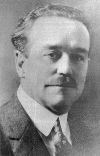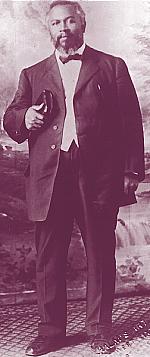

 ____________________________________________________________________________,
____________________________________________________________________________,
William J. Seymour, an African-American, was born May 2, 1870, in Centerville, Louisiana, to former slaves Simon and Phillis Seymour, who raised him as a Baptist. Later, while living in Cincinnati, Ohio, he came into contact with holiness teachings through Martin Wells Knapp’s God’s Revivalist movement and Daniel S. Warner’s Church of God Reformation movement, otherwise known as the Evening Light Saints. Believing that they were living in the twilight of human history, these Christians believed that the Spirit’s outpouring would precede the rapture of the Church. They deeply impressed the young Seymour.
After moving to Houston, Seymour attended a local African-American holiness congregation pastored by Lucy F. Farrow, a former governess in the household of Charles F. Parham. Parham led the midwestern Apostolic Faith movement, the original name of the Pentecostal movement, that had begun in his Bethel Bible School in Topeka, Kansas, in January 1901. By 1905, he had relocated his base of operations to the Houston area where he conducted revivals and started another Bible school. Farrow arranged for Seymour to attend classes. However, because of the “Jim Crow” segregation laws of the time, Seymour had to listen to Parham’s lectures while sitting apart from the other students. Seymour accepted Parham’s view of baptism in the Holy Spirit—the belief that in every instance, God would give intelligible languages—speaking in tongues to believers for missionary evangelism.
Neeley Terry, an African-American and member of the new congregation led by Hutchinson in Los Angeles, visited Houston in 1905 and was impressed when she heard Seymour preach. Returning home, she recommended him to Hutchinson, since the church was seeking a pastor. As a result, Seymour accepted the invitation to shepherd the small flock. With some financial assistance from Parham, he traveled by train westward and arrived in Los Angeles in February 1906.
Azusa Street Revival
Seymour immediately encountered resistance when, just 2 days after arriving, he began preaching to his new congregation that speaking in tongues was the Bible evidence of the baptism in the Holy Spirit. On the following Sunday, March 4, he returned to the mission and found that Hutchinson had padlocked the door. Condemnation also came from the Holiness Church Association of Southern California with which the church had affiliation. Not everyone in the congregation, however, was troubled by Seymour’s teaching. Undaunted, Seymour, staying at the home of church member Edward S. Lee, accepted Lee’s invitation to hold Bible studies and prayer meetings there. After this, he went to the home of Richard and Ruth Asberry at 214 North Bonnie Brae Street. Five weeks later, Lee became the first to speak in tongues. Seymour then shared Lee’s testimony at a gathering on North Bonnie Brae and soon many began to speak in tongues.
The second floor housed the office of the mission and rooms for several residents including Seymour and his wife Jenny. It also had a large prayer room to handle the overflow from the altar services below. One seeker described it as follows: “Upstairs is a long room furnished with chairs and three California redwood planks, laid end to end on backless chairs. This is the Pentecostal upper room where sanctified souls seek Pentecostal fullness and go out speaking in new tongues.”4
Still, the revival advanced slowly during the summer months with only 150 people receiving “the gift of the Holy Ghost and the Bible evidence.” But this changed in the fall as the revival gained momentum and people from far and wide began to attend. Missionary Bernt Bernsten traveled all the way from North China to investigate the happenings after hearing that the promised latter rain was falling.
Stories of the revival spread quickly across North America to Europe and other parts of the world as participants traveled, testified, and published articles in sympathetic holiness publications. Particularly influential was the Apostolic Faith (Los Angeles), issued occasionally between September 1906 and May 1908 through the labors of Seymour and Clara Lum, editors. Distributed without charge, thousands of ministers and laypersons received copies at home and overseas: 5,000 copies of the first edition (September 1906) were printed, and by 1907 the press run reached 40,000.
